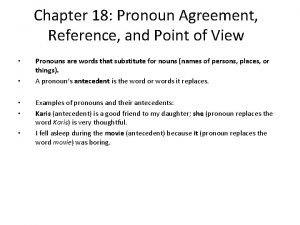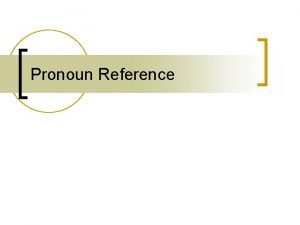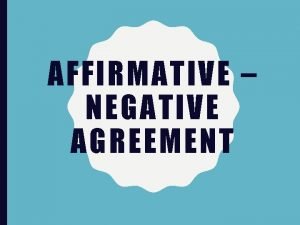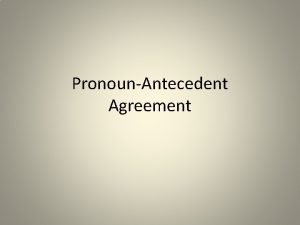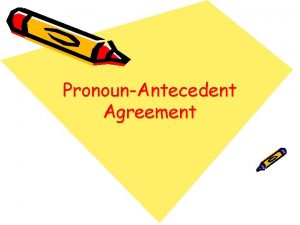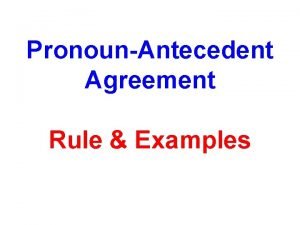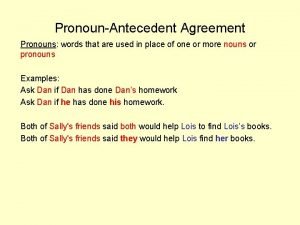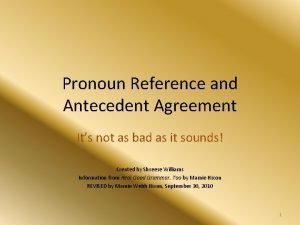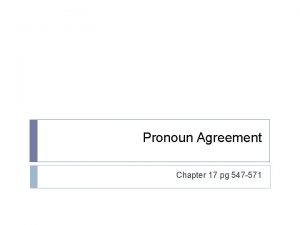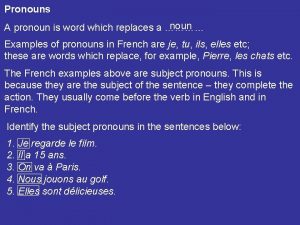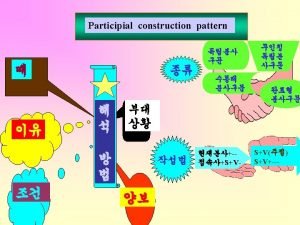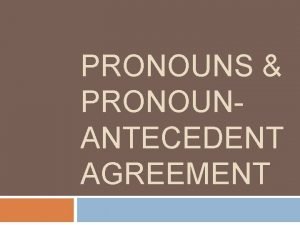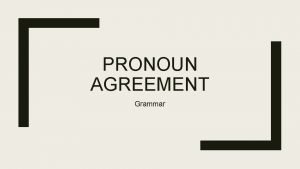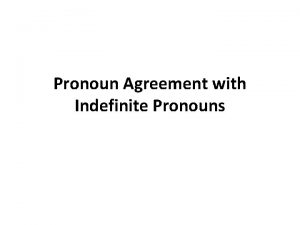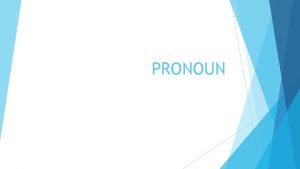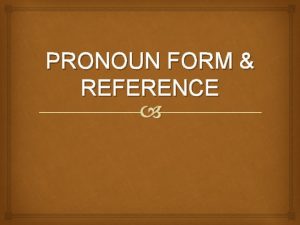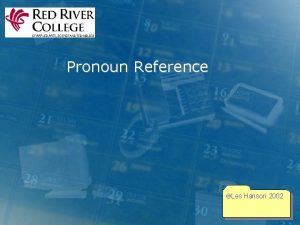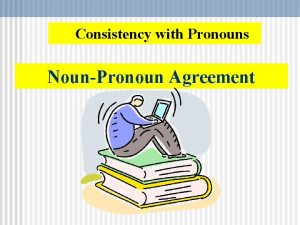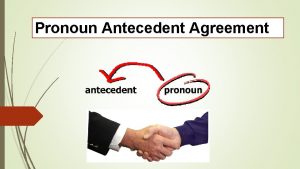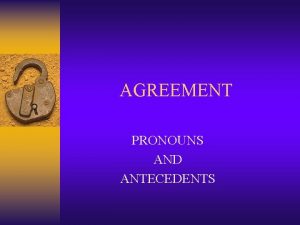Pronoun Agreement Reference Pronouns n Pronouns are words















- Slides: 15

Pronoun Agreement & Reference

Pronouns n Pronouns are words that take the place of nouns (persons, places, or things). n The word pronoun means “for a noun. ”

Pronouns n Pronouns are shortcuts that keep you from unnecessarily repeating words in writing. Here are some examples: n Kim had not finished her paper. (Her is a pronoun that takes the place of Kim’s) n Tim swung so hard on the branch that it snapped. (It replaces branch)

Pronouns n This power-point will present the rules that help you avoid two common mistakes people make with pronouns. The rules are: 1. A pronoun must agree in number with the word or words it replaces. 2. A pronoun must clearly refer to the word it replaces.

Pronoun Agreement n A pronoun must agree with the word or words it replaces. n If the word the pronoun refers to is singular, the pronoun must be singular; if the word is plural, the pronoun must be plural. n Note that the word a pronoun refers to is also known as the antecedent.

Pronoun Agreement n Here are some examples of agreement: Kayla agreed to lend me her Ray Charles CD. n Her refers to the singular word Kayla People walking the trail must watch their step. n Their refers to the plural word people.

Indefinite Pronouns n The following words, known as indefinite pronouns, are always singular. n -one words: one, anyone, everyone, someone -body words: nobody, anybody, everybody, somebody, & each, either, neither n

Indefinite Pronouns Here are some examples: Each father felt his child was the brightest. n One of the women could not find her purse. Everyone must be in his or her seat before the instructor takes attendance. ***If everyone in the last example was a man, you could use his. If everyone was a woman, you could use her. If the class has both sexes, or gender is unknown, use his or her.

Compound Subjects n A compound subject is formed by two or more words, phrases, or clauses joined by and, or, nor, either… or, or neither …nor. 1. When the parts of the antecedent are joined by and, use a plural pronoun. 2. When the antecedent is preceded by each or every, use a singular pronoun.

Compound Subjects 3. For singular antecedents joined by either…or , or, neither …nor, use singular pronouns. 4. For plural antecedents joined by either…or , or, neither …nor, use plural pronouns. 5. If one singular and one plural antecedent are joined by or, either…or, neither…nor, be sure the pronoun agrees with the antecedent closest to it.

Collective Nouns Collective nouns have a singular form & refer to a group of people or things. Some are: Audience, panel, band, class, team, society, jury. n 1. If the group is functioning as a single unit, the pronoun is singular. A civilized society must protect its citizens. 2. If the members of the group are functioning individually, the pronoun is plural. The team signed their contracts for next season.

Pronoun Reference n A sentence is confusing & unclear if a pronoun appears to refer to more than one word, or if the pronoun does not refer to any specific word. n There are two types of mistakes that writers often make: ambiguous reference & unstated reference.

Ambiguous Reference Ambiguous reference occurs when the reader cannot tell which antecedent the pronoun refers to. Ex. When Joe placed the heavy vase on the shelf, it broke. § What broke? The vase or the shelf? § To correct this sentence, replace the pronoun with a noun. Ex. When Joe placed the heavy vase on the shelf, the shelf broke. §

Unstated Reference n Unstated reference occurs when a pronoun has no antecedent to refer to. 1. U. R. occurs when a pronoun refers to an unstated form of a stated word. Ex. Carla is ambitious. It causes her to work often. n It is meant to refer to ambition, but only ambitious appears. 2. U. R. occurs when this, that, which, it, or they has no stated antecedent. To fix this, supply the missing word. Ex. Joe dropped out of school, for he felt they emphasized discipline too much.

Unstated Reference 3. U. R. occurs when you appears with no antecedent. To fix this, replace the pronoun with a noun. Ex. The teacher becomes frustrated when you do not ask questions. 4. U. R. occurs when a subject pronoun refers to a possessive noun. To fix this, replace the noun with a pronoun and the pronoun with a noun. Ex. In Barbara Kingston’s novels, she writes about strong women.
 Insidan region jh
Insidan region jh Pronoun agreement and reference
Pronoun agreement and reference A list of pronouns
A list of pronouns Affirmative and negative agreement exercises
Affirmative and negative agreement exercises Antecedent pronoun agreement
Antecedent pronoun agreement Pronoun antecedent agreement meaning
Pronoun antecedent agreement meaning Pronoun-antecedent agreement examples
Pronoun-antecedent agreement examples Titles of single entities examples
Titles of single entities examples Pronoun antecedent examples
Pronoun antecedent examples Measurement subject verb agreement
Measurement subject verb agreement Pronoun attendance agreement
Pronoun attendance agreement Pronoun case agreement
Pronoun case agreement What are pronoun words
What are pronoun words Who which that
Who which that What is the basic principle of pronoun antecedent agreement
What is the basic principle of pronoun antecedent agreement Pronoun and antecedent
Pronoun and antecedent

